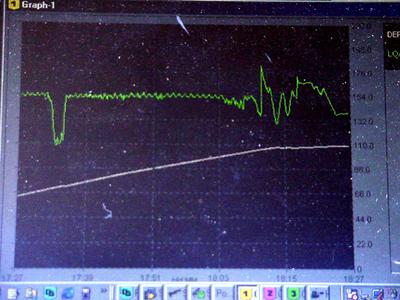21 July, 2002
Drilling.......
Bob Bigl, a scientist from CRREL in Hanover, NH agreed to redrill the bore
hole that for me that was plugged. He had to first drill another hole for a
water flow study. So I went out with him today to get an idea of how his
drill rig works.
The drill rig is attached to a large aluminum sled that can be pulled across
the ice relatively easily with an ATV. We had to first move the rig into
position and then attach all of the hoses and wires that allow it to work.
See image below.
The drill operates by forcing hot water (over 200oF) under pressure through
a large brass head. The hot pressurized water easily cuts its way through
the ice. Through clean ice, the apparatus drills about 1m/min., but slows
considerable when debris or dirty basal ice is encountered.
The drill has a series of probes that monitors several factors including
depth, water pressure, load on the drilling boom, and water temperature.
Careful monitoring of these factors can give information about the ice at
different depths. For example, the load reading will change if a debris
band is encountered because the head of the drill will ³bounce² which causes
the load to change rapidly.
The hole that was bored out reached the bottom of the glacier at a depth of
108m. Dye was sent done the hole as part of a tracer experiment that is
attempting to gain a better understanding of sub glacial drainage systems.
Tomorrow the drill rig will be moved up to the hole that I will be using and
hopefully a bore hole will be opened up. If all goes well, I should be able
to start with my project on Tuesday. Keep your fingers crossed.......
Life Is Good,
DT

Readout from the data collected during drilling. The yellow line at the bottom shows depth, and the green line near the top indicates load. The jog in the load reading on the left hand side is from a fuel change over the jogs to the right indicate the drill head is boring through debris rich basal ice.
Contact the TEA in the field at
.
If you cannot connect through your browser, copy the
TEA's e-mail address in the "To:" line of
your favorite e-mail package.
|
